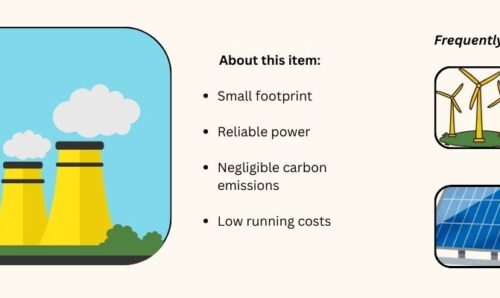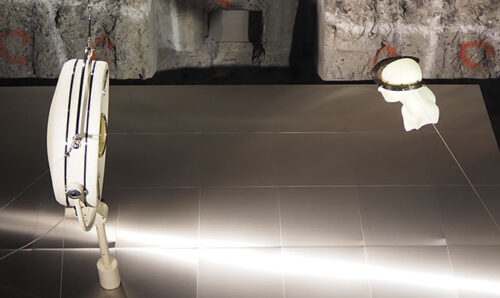The Power of the Special
Blog 26 May 2023
Authors: Petra Tjitske Kalshoven, Lecturer in Social Anthropology, School of Social Sciences, The University of Manchester, and Richard Taylor, BNFL chair in Nuclear Energy Systems, Dalton Nuclear Institute, The University of Manchester
Petra Tjitske: This semester, I taught the Materiality and Representation course for second-year Social Anthropology students and included a lecture session on ‘The stuff of nuclear decommissioning’. The course introduces students to the ways in which objects and materials shape human worlds. They learn about different conceptual frameworks that have been developed in anthropology and philosophy (such as phenomenology and semiotics) to think about sensory perception of the material world and about relations between humans, their stuff, and their built environments.
Research-led teaching is what I enjoy most, so I drew on my ethnography of decommissioning around the Sellafield facilities in West Cumbria to lecture on the materiality and materials involved in nuclear endeavours, with an emphasis on the political and social relations and the corporate rhetorics that are an integral part of the management of nuclear waste and the large infrastructure projects it requires. In this specific lecture, sensory experience was particularly intriguing to discuss: how is invisible radiation characterized, conceptualized, and visualized? How to engage with objects and structures that have been contaminated, or with the vibrancy of nuclear materials? To treat students to some first-hand insights into a practitioner’s perspective and indeed his relationship with such elusive materials, I had invited the Beam’s Richard Taylor to speak to the class following the lecture.
Richard Taylor: Last week I spoke to a class of undergraduate anthropology students about the nature of my work with so-called Special Nuclear Materials (those fissile isotopes from which spring all the promise and the peril in the ‘nuclear’). This was an unusual gig for someone with my history (nearly 40 years as a practicing engineer on nuclear projects), but in preparation for the event I had the opportunity to reflect on the power of the ‘material’ in all our nuclear endeavours.
So, here’s the thing. For me at least there is something around my relationship with these materials that goes beyond the mundane and transactional, something ‘other’ here that taps straight into the emotions as well as the intellect. Perhaps there is a clue in the range of rich and often anthropomorphic adjectives I was able to apply to the materials and their behaviour. Beguiling, capricious, beautiful, the list goes on…
In the same way you cannot step twice into the same river, you are similarly thwarted from looking twice at the same container of these most special materials. A can of plutonium is ever-changing, it morphs and transmutes continually in a strange dance of modern alchemy. It is both restless and relentless and seethes with latent power in a way that cannot fail to slog you in the gut. I once got up close to a brick of ridiculously highly enriched uranium (let’s not go into where and why) and it put a charge into me that I can still recall today.
Ok, the stuff is unremarkable to look at as a powder but in the right solution it is undeniably beautiful. A glass vial of Pu III is the most lovely lavender shade and the most magic of potions, making it both enchanting but also deceptive (don’t drink it whatever you do!) If you get yourself a sample of the really good stuff you will find it approachable, you could safely pick it up and tuck it under your arm, but give it a bath and it will turn on you with a merciless fury. If you trap it in a cylinder, it will turn it into a rugby ball and eventually split it like a peach. If you send it from the solar system (which we have, as power sources for the Voyager Interstellar Space Probes) it will go implacably on, a testament to human hubris for some other intelligence to discover.
In the nuclear biz Plutonium is widely described as a ‘zero value asset’, i.e. it is seen as having the potential to become valuable in the future, but is not considered to have any worth in the here and now. This is perhaps the most compelling illustration of a relationship that is both complex and tangled in a ‘can’t live with it, can’t live without it’ sort of way. Plutonium is a human-made construct unknown to our nature. We have brought it into being and set up a dynamic where we hold the dominion, but the material holds the power. How will that relationship end? Who knows, but let’s all acknowledge it is a relationship and that seems like a place to start.
Petra Tjitske: Richard’s talk in class and his reflection here speak eloquently to what’s key in materiality: teasing out the relationships we have with things and ‘stuff’. The account also raises questions for me, the kind of critical questions a social scientist is keen to explore. What is the status of plutonium as a zero value asset, and who decides on this status? What would be the consequences of such decisions, for example when one considers the inventory of a potential geological disposal facility? And who might the ‘we’ be in the final paragraph—is plutonium there for scientists only, to admire and flirt with its power? Who exactly is the relationship with – a selected few who hold that dominion? Which ‘we’ will decide about this relationship—and can ‘we’ opt out of it?
To be continued for sure!
About Richard Taylor
Richard is BNFL chair in Nuclear Energy Systems at The University of Manchester’s Dalton Nuclear Institute. He was previously the Chief Engineer of the UK’s National Nuclear Laboratory. Richard is a co-founder of The Beam nuclear and social science network. Read more.
About Petra Tjitske Kalshoven
Petra is a Lecturer in Social Anthropology based in the School of Social Sciences at The University of Manchester. With The Beam, she pursues her interest in human expertise and the skilled and persuasive ways in which people seek to engage specific materials and landscapes. Read more.





Leave a Reply